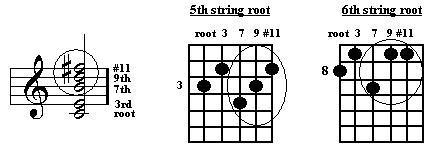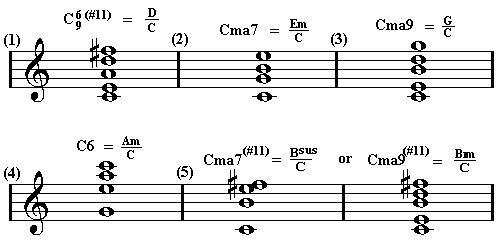Altered Major 9
As previously discussed, the upper extension 7th chord of a major 9th chord is a minor 7th chord based on the 3rd: Cmaj9 = Emi7/C. The upper extension triad of Emi7 is G major. Thus the upper extension triad for Cmaj9 is G major.
The most commonly altered major 9th chord is the major 9, sharp 11. The 11th is the octave of the 4th so the sharp 11 is the same thing as a flat 5. Occasionally you'll see Cmaj9(b5) but more often it will be written Cmaj9(#11).

As you can see, the upper extension triad has changed from G major to B minor (Gb - B - D is a 2nd inversion B minor triad). The chord is now bitonal (see text box on the left). The soloing over this chord would be based on a B minor triad. In a voicing more suited to the guitar, the B minor triad is clearly seen on the top of the chord:

Below are a couple of examples of how to drill. The first example adds a 2nd to the B minor triad. The 2nd must be a minor 2nd (C) rather than a major 2nd (C#) because the added note must be consonant with the "parent" chord (the minor 2nd (C) would create the B Phrygian Mode). The second example adds a 4th to the B minor triad. The first bar of each line corresponds to a root position triad. The second bar corresponds to a 1st inversion triad, and the 3rd bar of each line corresponds to a 2nd inversion triad. Strum the chord to set the tonality in your ear, then play what's written. Do each line in all twelve keys around the Key Circle. The next chord would be Fmaj9(#11). The bitonal triad is E minor. The next chord would be Bbmaj9(#11). The bitonal triad is A minor - and so on.
Cmaj9(#11): Example 1: add a 2nd:

Cmaj9(#11): Example 2: add a 4th:

Another altered 9th chord that's very similar to the Cmaj9(#11) is C6/9(#11). The 7th has been replaced by the 6th - everything else is the same. The bitonal triad is now D major. The bitonal spelling is D/C. A voicing suitable for the guitar is this:

The D major triad can be clearly seen on the top of the chord.
C6/9(#11): Example 1: add the 2nd:

C6/9(#11): Example 2: add the 4th:

The upper extension/bitonal triads for Major-type chords are given below.
Numbers 1 and 5 are bitonal. Numbers 2,3, & 4 are merely extensions.

These should be drilled per the examples given above in every key around the Circle.


